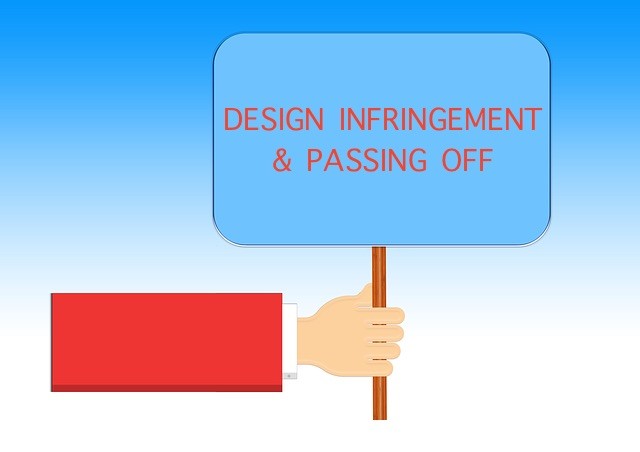There is no such aesthetic beauty similar to Taj Mahal in this whole world. Why so? Well, we all would have heard that Shah Jahan cut off his workers’ hands so that there can be no replica of it. Knowingly or unknowingly this was recognition of the doctrine of Passing-off. Nobody can give up on their identity so easily, right?
The Doctrine of Passing off is already discussed in detail in one of our previous blog posts. So, I take it as an excuse to focus only on the correlation between design infringement and passing off remedy. The words of Lord Halsbury, “Nobody has any right to represent his goods as the goods of somebody else”, give us a brief insight on the idea of passing off. One has to establish his goodwill, misrepresentation of his goods, and the damages thereof, to succeed in his passing off claim.
Design Infringement and Passing Off
Passing off was once considered to be a common law remedy available only to trademarks. But, an inclusion of the scope of passing off to designs leads to various interesting debates and questions in the IP arena. This article would help in understanding the conundrum with referrals to various case laws throughout it.
The key issues involved are:
-Availability of common law remedy of passing off under the Designs Act, 2000.
-Continuation of a mark as a design which has gained trademark status.
-Composite suit of Design Infringement and Passing off.
-Passing off suit against a design registrant.
Availability of common law remedy of passing off under the Designs Act, 2000
What is the first thing that pops into your mind when I say iPhone? There is no doubt that it is the design of such phones which are distinct from the rest, right? It is such designs which become the identity of any brand, and the very purpose of the passing off claim is to shield that identity.
Earlier, the common law remedy of passing off was available only to trademarks. It was for the first time in the case of SmithKline Beecham v. Hindustan Lever, the Delhi High Court held that passing off remedy is available also to the designs under the Designs Act. Justice Sharma in stating the reason has mentioned that it is to protect misrepresentation of designs by a third person, which have eventually become the identity of a brand. The larger bench of the Delhi High Court upheld the same in Micolube India v. Rakesh Kumar.
It is a well-settled law that the passing off is a common law remedy which exists over and above the protection of statutes. Then why were the courts hesitant to allow the same? The single judge ruling in the Micolube case states that there was lack of legislative intent in the Designs Act to provide the remedy of passing off. This absence of express provision in the Designs Act, unlike the Trade Marks Act, justified this issue for a long time. But, later the full bench in the same Micolube case was very much pragmatic. They held that the single judge framed the issue incorrectly, namely, ‘Whether there exists any remedy of passing off under the Designs Act?’ Then, the answer is pretty simple that there is no such remedy mentioned in the Designs Act.
I would agree with the full bench. As I have said earlier, passing off protects the identity of a brand. Then, if a design becomes such identity, it is more than appropriate to provide the same remedy to designs. The plaintiff in the case of Good Earth v. Krishna Mehta established that any consumer would recognize their brand with their designs, which made them succeed their suit claiming passing off against India Circus.
Continuation of a mark as a design which has gained trademark status
Section 19(1) (e) of the Designs Act clearly states that a registered design can be cancelled if it ceases to continue as a design. It is better to have a clear picture on the definition of design to understand this provision.
Section 2 has specifically given that only the features of shape, configuration, pattern, ornament or composition of lines or colours applied to any article are designs under the Designs Act. It also specifically excludes the following from the ambit of this definition.
-Any trademark as defined in Trade Marks and Merchandise Act.
-Any mode or principle of construction which in substance a mere mechanical device.
-Property mark as defined in IPC
-Artistic work as defined in Copyrights Act.
This gives us an insight that when a design is a trademark, then it cannot be registered.
So, what if a design after registration has become a trademark by use?
Earlier, the courts had an interpretation that the very moment a design becomes a trademark by use then it no longer can enjoy protection under the Designs Act. It is ordinary for a distinct design of a brand to acquire reputation and serve as a trademark. Should the proprietor of the design brood over it?
The full bench had a different understanding of this interpretation. This reasoning broke the stereotype so far. This is simple in understanding that any design which was a trademark cannot be registered as a design, and whereas the design after registration becomes a trademark by use, it can continue to be a design. This is an overlap of the IP rights.
A design which has become a trademark is untouched by Section 19 of the Act. Section 2 excludes only the design which is a trademark at the time of application for registration of a design.
Composite suit of Design Infringement and passing off
It is still a mystery that when there can be composite suits of trademark infringement and passing off, or trademark infringement and copyright infringement, why is it impossible to file a composite suit for design infringement and passing off. The decision in Mohan Lal v. Sona Paint is straightforward that a composite suit for design infringement and passing off is not maintainable. They placed reliance on the Supreme Court’s decision in Dabur India Limited v. KR Industries in which it was held that two causes of action cannot be clubbed into a composite suit, only where they do not arise within the jurisdiction of the same court.
The Court in Mohan Lal case has also disregarded Order 2 in Rule 3 of CPC, which permits joinder of causes of action. After all, the intention of CPC is to prevent multiple suits regarding a same issue.
However, last month the Delhi High Court in the case of Carlsberg Breweries has felt that the decision needed reconsideration and referred the matter to a larger bench. It is better to understand Design Infringement and Passing off of the same design as a string of actions rather than different causes of action. Though both have different grounds, as design infringement as novelty or not original, and passing off as misrepresentation, both affect the goodwill earned by the brand.
A revision in the maintainability of the composite suit is the need of the hour and would be hailed.
Passing off suit against a design registrant
The Bombay High Court in Whirlpool v. Videocon has upheld the scheme of Section 22 of the Designs Act which calls for the interpretation of “any person” as provided in this section. The term “any person” qualified with the phrase “other than the registered proprietor” created an ambiguity that whether it excludes any other registered proprietor or it makes liable all other persons other than the registered proprietor of such design.
Just because a monopoly right is given to a registered proprietor, he cannot infringe the rights of other registered proprietors, right? Passing off remedy never allows any “other person” to represent his goods as the goods of somebody else. This would widen the scope of maintainability of passing off in a design infringement. The same was emphasized in the practice of Indian design infringement and passing off suits with the help of courts.
Conclusion
Besides everything, I must agree that designs law regarding infringement is constantly evolving. A recent judgment of the Bombay High Court in Cello v. Modware has discussed the issue with a different facet envisioning the scope of mosaicing of prior art in designs.
Is it a herculean task for you to read the above piece? I sum it up for you.
-Yes, you can file a suit of passing off for protecting your design.
-Yes, your design is still protected under Designs Act even after it becomes a trademark.
-Yes, you can file a passing off suit against a design registrant.
-I guess you have to wait a little longer to file a composite suit of passing off and design infringement.
The laws are providing every means to protect your intellectual property. On your part, know and utilize it.




